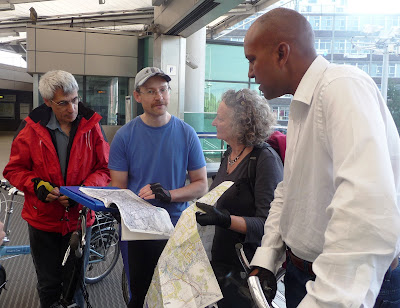 |
| An 'urban style' school in Westminster |
I attended last night's Brent Executive meeting to hear the discussion on the Primary Places Strategy and was able to make a short presentation on some of the issues that arise. These are the notes of my contribution:
1. Recognise the difficulty regarding the shortage of school places and welcome development of a longer term strategy.
2. Agree need for intensive lobbying of government with similarly affected boroughs – not just a local issue. This should include funding for new 2FE schools in areas of need.
3. The consultation paper left out fact of submissions from at least two governing bodies – impression they were all headteacher or individuals. In fact a long and passionate discussion involving staff and parent governors took place.
4. Proposals mean demise of one form entry schools that have their own strengths, particularly in terms of helping vulnerable children in an intimate and safe setting. (Return to that later)
5. Draw attention to some issues that arise from the suggested strategy – the impact of all-through schools on neighbouring primaries – long-term residents will choose all-through school at 4 because it guarantees a place in the secondary school. May destabilise stand-alone primaries with disproportionate number of new arrivals and high turn-over.
6. All through schools will reduce the number of secondary places available for pupils from stand-alone primaries. If Alperton and Wembley as proposed become all-through, this with Ark and Preston Manor would reduce Year 7 places available in North Brent by 300.
7. This would impact on children from the South as they would lose out on the distance criterion. Raises equality issues.
8. Need clarification of what is meant by ‘urban style’* school mentioned in 3.3 but not followed up.
9. Need to have strategy on how to maintain ‘primary ethos and character’ in all through provision. Perhaps have a separate governing body to that for the secondary phase or additional governors experienced in early years/primary education.
10. Possible alienation of small children in large 5 form entry schools (six proposed). Need to research also how to preserve the family-centred ethos through options such as ‘small schools’ within larger ones.
11. In the context of the recent disturbances need to think carefully about the form of our schools so as to reduce the possibility of alienation and disaffection of young people. If one of the ‘causes’ is lack of family support then schools need to be able to provide the safe, supportive structure sometimes missing from children’s own families. Is this better provided in smaller schools? Links with present consultation on Breaking the Child Poverty Cycle.
12. As Brent schools become larger ‘free schools’ may step in to provide the small, friendly, family-centred schools –‘where everyone knows your name and you can’t get away with anything’ that many parents prefer. There are signs that free school providers are already homing in on this.
* An officer said that 'urban style' schools mean schools on 'constrained sites' such as some in Westminster. I take it that means schools with very little space in an urban environment.Soho Parish C of E School for example limits classes to 20 because of space constraints. Quite a few of the older buildings have roof playgrounds to maximise the small amount of play space they have.
In response Cllr Mary Arnold, lead member for Children and Families, said that the Council realised this was a serious issue and that was why they went out to consultation. She welcomed the feedback on the consultation and said that important points had been made, including those about 'small school' solutions within larger units and separate governing bodies for the primary phase of all-through schools. Cllr Lesley Jones echoed concerns about the impact of all-through schools on stand-alone primaries and said this issue had been worrying primary schools in her area. Cllr Ann John, following up comments about the riots and child poverty, said that Cllr Helga Gladbaum had chaired a group looking at an Early Intervention Strategy and that their proposals would be published soon.








